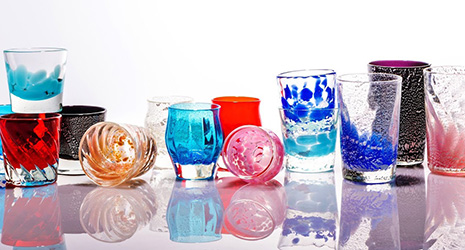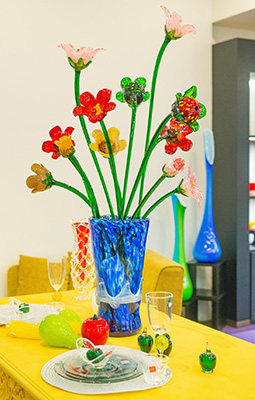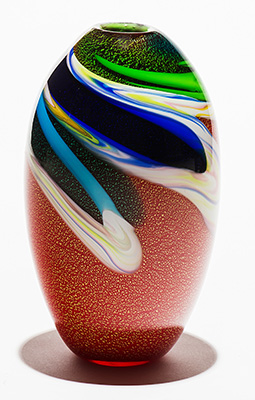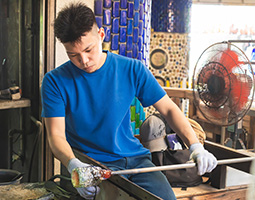November 2022
- English
- 日本語
Ryukyu Glass, a Traditional Craft of Okinawa

Colorful Ryukyu glass tumblers 
Tumblers of awamori (example photo)

Ryukyu glass tumbler with characteristic bubbles 
Ryukyu glass vases, tableware, flowers and fruits 
Shimageshiki (Okinawa island scenery) Ryuku glass vase by Taira Tsuneo, recognized by the Japanese government as a Contemporary Master Craftsman 
A craftworker making Ryukyu glass at the Ryukyu Glass Village workshop

Ryukyu glass is characterized by its bubbles and colors that evoke the beautiful, sub-tropical islands of Okinawa Prefecture.

Ryukyu glass takes inspiration from the colors of the beautiful sea and sky and the flowers that grow abundantly in Okinawa, on Japan’s southern edge. It was designated a traditional craft of Okinawa Prefecture in 1998, and Ryukyu is the old name for Okinawa.
It is thought that glass production in Okinawa began around 1900. Glass workers from the Satsuma district of Kagoshima Prefecture brought their techniques to Okinawa, and later glass workers from Osaka and Nagasaki moved to Okinawa, refining their techniques and spreading glass production. Around this time, glassblowing, in which a shape is formed by blowing air through a blowpipe to inflate the glass, was adopted, and everyday items such as bottles for medicine or candy were made. A number of glass workshops were set up, mainly in Naha City, the central city of Okinawa, and in each of these workshops artisans started making elaborate glass products by hand. Glass workshops suffered catastrophic damage during World War II, but after the war, surviving glass artisans banded together and started work making glass products again.

Postwar Okinawa was under the administration of the United States, and there was a rush on orders for everyday practical glassware and souvenirs on the way home for stationed military personnel and their families. However, at that time after the war, there was a shortage of various resources, and shortages in raw materials for glass (see here) were no exception. Production could not keep up. Glass workers turned their attention towards the large quantity of empty beer and cola bottles discarded by US military facilities. They thought that they could wash the bottles, melt them in a furnace, and bring them back to life as new glass products. But as this bottle glass contained bits of labels that couldn’t be removed and other impurities, there were many products created that had bubbles mixed in with the glass. Normally, glass products with bubbles were considered defects, but the bubbles were accepted as unique features and became known as a characteristic of Ryukyu glass.
Another characteristic of Ryukyu glass is the colors. These come from the color of the discarded glass bottles used as raw materials. For example, brown came from beer bottles, light blue came from 1.8 liter liquor bottles, and green came from juice bottles. There are many other bright, sub-tropical Okinawan colors produced, for example purple and dark blue, made by mixing in manganese dioxide and cobalt coloring agents, respectively.

In recent years, uses for the glass have expanded, not only for tableware and other everyday goods, but also for decorative works and other art pieces. Owing to the rise in use of plastic bottles, discarded glass bottles cannot always be acquired, so there are now also Ryukyu glass products made by mixing silica sand, soda ash, lime, and other materials in the same way as ordinary glass. Techniques to produce bubbles using such glass have been created and there are some products with countless bubbles.
Nowadays, there are many factories and tourist facilities in Okinawa Prefecture where visitors can buy and make Ryukyu glass. One of these is the Ryukyu Glass Village in Itoman City, a little south of Naha. The shop sells over 1,500 varieties of handmade Ryukyu glass, and visitors can create their own unique glass in the workshop with support from a glass worker.

Kawakami Hidehiro works for RGC Co., Ltd., the company that runs Ryukyu Glass Village. “Ryukyu glass has come to be loved by many people, popularized as a product symbolizing the recovery and rejuvenation of postwar Okinawa. Through technical exchanges with workshops in Venice, a leading city in glass work, we are creating Ryukyu glass that incorporates more advanced techniques and designs. I hope that we can spread the allure of Ryukyu glass to the world in the future.”
Ryukyu glass features colors that evoke the beautiful nature of Okinawa, and the air bubbles offer a unique flair. The charm of this glassware is meant to be enjoyed along with Okinawan cuisine and awamori*, a specialty Okinawan spirit.

* A distilled spirit made in Okinawa using black koji mold and rice as raw materials

